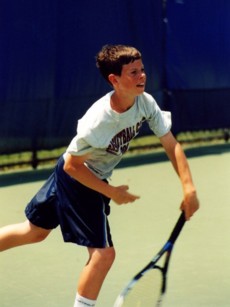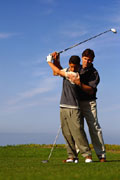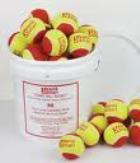Which youth sport, golf or tennis, is gaining in popularity in recent years, and which is losing? You might be surprised to learn, given their overall public profiles, it is the number of youth tennis players that is up, with participation jumping 43% since 2000 , with the USTA's innovative QuickStart and No-Cut programs credited for the increase.
For years, I have been on a mission to change the culture of youth sports: to think about sports, not just as a place to showcase the gifted and talented but as a place where all children can begin a love affair with sports and physical exercise lasting a lifetime, instead of ending, as too often is the case, in early adolescence.
To grow a sport is actually pretty simple, if you implement a five-part strategy:
-
Shrink courts, fields and diamonds down to size for the youngest kids (this is something youth baseball and soccer have been doing for years, of course);
-
Give younger kids age-appropriate equipment with which to play;
-
Increase access by building more courts, fields and diamonds and use the "power of the permit" to give preference in using existing facilities to programs that are inclusive and child-centered; and
- Bring women and mothers out of the bleachers and from behind the counter at the concession stands and on to the coaching sidelines and into the board room.
In other words, make sports more fun, more inclusive, more accessible and no longer a No Mom's Land.
Growing youth tennis: recipe for success
According to a recent article in The Wall Street Journal, it is formula that the United States Tennis Association (USTA), the folks in charge of tennis in this country, have used with great success to grow the sport of tennis.
 Putting a lie to the myth that kids' participation in tennis
would rise and fall with the rankings of U.S. pros, the USTA has been able to increase the number of
children age 6 to 17 playing tennis from 6.8 million to 9.5 million (43%) since
2000, according to the Sporting Goods Manufacturing Association. To do it, the USTA basically followed my four-pronged strategy:
Putting a lie to the myth that kids' participation in tennis
would rise and fall with the rankings of U.S. pros, the USTA has been able to increase the number of
children age 6 to 17 playing tennis from 6.8 million to 9.5 million (43%) since
2000, according to the Sporting Goods Manufacturing Association. To do it, the USTA basically followed my four-pronged strategy:
-
Grab kids early with the USTA QuickStart tennis program, an affordable ($500) and fun child-version of the game using foam balls and played on a "court" (gymnasium floor, parking lot, driveway) about one-fourth the size of a regulation court.
-
Keep high school kids playing with the USTA "no-cut" program in which, in return for discounted equipment and training help, participating high schools (3,000 at last count) agree to let every kid who wants to keep playing tennis practice with the full team, even if they don't get to play against other schools;
-
Maintain the interest of college players by supporting club and intramural co-ed tennis. Of the 290,000 high school players who aren't able to make it on to college rosters, 40,000 are now playing club and intramural tennis, making it one of the fastest-growing club sports at the collegiate level; and
-
Provide seed money for new or refurbished courts: The USTA has contributed $5 million over the past six years as part of a $50 million program that has built or re-built 2,600 courts across the country.
Again, notice the theme here: making tennis more fun, more inclusive, and more accessible to kids, teens, and young adults so that it becomes a sport that provides a lifetime of enjoyment.
Youth golf: off course?
On the flip side of the coin, I also wasn't surprised to read in the same Journal article about the decline in the number of youth golfers.
Despite programs such as The First Tee, the well-publicized national program aimed at introducing younger players to the sport, and the infusion of $65 million in grant money by the United States Golf Association, some of it specifically targeting increasing access to golf by youth golfers, the number of youth golfers (age 6 to 17) dropped 24% from 3.8 million to 2.9 million between 2005 and 2008.
The reason is obvious: unlike tennis, little has been done to make golf kid- and family-friendly.
- Regulation, 18-hole courses are way too long for kids (the Journal article put it best by posing the following question and answer: "Want to make an eight-year old cry? Tee up a ball for him on a 450-yard hole with a green surrounded by bunkers and tell him to hole out before the group waiting to tee off starts complaining to the course superintendent.")
- Most of the new courses being built are resort and premium courses, not accessible, affordable courses for kids and families. While there are 492 more courses in the U.S. today compared to 2000, the number of id- and family-friendly 9-hole and par-3 courses have dropped and pitch-and-putt courses where kids and families "can hone their skills playing a mini-version of the game that doesn't involve putting through a windmill" are, sadly, few and far between.
Among
the suggestions offered by those interviewed for the Journal article
for growing youth golf:

- start kids out on the putting green, instead of the driving range, to build success (and a love of the game and self-esteem) with a shorter swing before progressing to a longer one;
- build more 9-hole and pitch-and-putt courses, and
- retrofit existing courses to include "mini-tee boxes" 130, 230 and 300 yards from every hole, so a family can play together.
Again, notice the theme here: grow the sport by making it more fun, more inclusive, and more accessible to kids.
Lessons learned
As a lifelong golfer, it was sad to hear about the decline in the number of young golfers. But not only was I happy to hear about the USTA's success, but I was gratified to have played at least some small role in the new programs it has initiated to grow youth tennis.
In August 2007, nine months before the launch of the QuickStart program, I was asked by executives at the USTA to advise them on the roll-out of the new program. They had read my book, Home Team Advantage: The Critical Role of Mothers in Youth Sports, and thought I could help them on ways they could "avoid the problems that [some] of the national youth sports organizations have encountered over the years," including the conflicts between parents and coaches that had plagued many other youth sports organizations. Hours of consulting time ultimately led the USTA to invite me to attend the 2007 US Open in Flushing Meadows, where I delivered a keynote address to USTA's Regional Directors who were charged with growing youth tennis by making the sport fun for kids to learn.
 It thus comes as no surprise to me that USTA Youth Tennis has grown as fast as it has since the QuickStart program was launched close to three years ago. They went to school on the mistakes so many national youth sports organizations have made, which have led to declines in their participation numbers, and followed my most important advice: critical to growth and success in youth sports participation is to value and include women's voices, not only as team parents but as coaches and administrators.
It thus comes as no surprise to me that USTA Youth Tennis has grown as fast as it has since the QuickStart program was launched close to three years ago. They went to school on the mistakes so many national youth sports organizations have made, which have led to declines in their participation numbers, and followed my most important advice: critical to growth and success in youth sports participation is to value and include women's voices, not only as team parents but as coaches and administrators.
Bravo USTA! Game, set, match!









